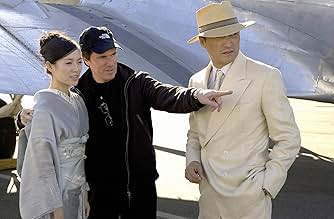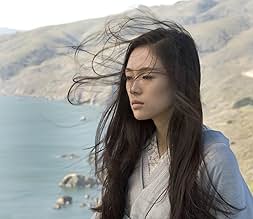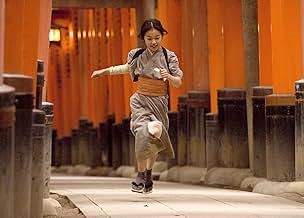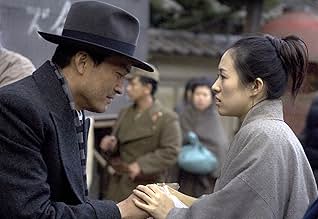Nitta Sayuri rivela come è riuscita a trascendere le sue radici legate a un villaggio di pescatori e a diventare una delle geishe più illustri del Giappone.Nitta Sayuri rivela come è riuscita a trascendere le sue radici legate a un villaggio di pescatori e a diventare una delle geishe più illustri del Giappone.Nitta Sayuri rivela come è riuscita a trascendere le sue radici legate a un villaggio di pescatori e a diventare una delle geishe più illustri del Giappone.
- Vincitore di 3 Oscar
- 32 vittorie e 47 candidature totali
Recensioni in evidenza
As someone who read the book before watching the movie, I was pleased with the adaptation. The right parts were highlighted and felt the cuts made were necessary for length. The story is truly a tragically beautiful one, and the actors cast fit their characters. Great acting and some beautiful cinematography. Sayuri's dance scene was mesmerizing.
Going into the film, I had worries with all the slamming critics have given, even though I didn't read all of them in details. However, I'm happy to say it turns out to be one of more satisfying movie experiences of the year.
First I echo the sentiment that the film is simply technically perfect. The retro-mood it created had me immensed in the world of geisha from beginning to the end. It's very 1930 Shanghai like. The music score isn't as haunting as the one in CTHD, but it is still masterfully composed and fits in the background very well. It's worth seeing for the big screen experience alone. The story also never dragged, as each of the three parts flowed nicely. I normally don't like voice-over, but here it really held the movie together and helped to move the story along.
As for the accents, the problem has definitely been exaggerated. I was expecting a lot of unpleasant broken English to be spoken, but they all sounded fine to good, not just from the most fluent Michelle Yeoh, but Ken Watanabe, Youki Kudoh (who plays Pumpkin) and other supporting casts. Gong Li had a few awkward lines at the beginning, and Ziyi had more and is the one who had to try the hardest, but both pulled off admirably and didn't hurt their performances in the process.
Talking about performances, I think almost all of them did well. It's much more of an ensemble piece, and I was especially impressed by the young Sayuri and Ken Watanabe.
The main problem I have is with character development. It is a Cinderella story at heart, but the good and evil are too clear-cut and lack dimension. I also want to see more ups and downs for the competition between Ziyi and Gong Li. Gong did all she could, but the script didn't allow her to be a worthy opponent. Except for some verbal back-and-forth between the two and a few dirty tricks from Gong, there was no reason to believe why she was the most famous geisha in Japan before Ziyi arrived.
In addition, the Mother character is over-the-top and didn't fit the emotional aspect the film quite well, although she did provide some comical moments. The big dance scene had excellent buildup, but the execution of the dance felt flat. It lasted only about 30 seconds, while doubling that and making it more mesmerizing would have made the whole middle act more effective.
These flaws didn't overshadow the fact that what was put on screen worked for me. Will I be willing to watch it again with friends? In a heartbeat. Will I recommend it to others? Definitely. With that in mind, I give the film an A-.
First I echo the sentiment that the film is simply technically perfect. The retro-mood it created had me immensed in the world of geisha from beginning to the end. It's very 1930 Shanghai like. The music score isn't as haunting as the one in CTHD, but it is still masterfully composed and fits in the background very well. It's worth seeing for the big screen experience alone. The story also never dragged, as each of the three parts flowed nicely. I normally don't like voice-over, but here it really held the movie together and helped to move the story along.
As for the accents, the problem has definitely been exaggerated. I was expecting a lot of unpleasant broken English to be spoken, but they all sounded fine to good, not just from the most fluent Michelle Yeoh, but Ken Watanabe, Youki Kudoh (who plays Pumpkin) and other supporting casts. Gong Li had a few awkward lines at the beginning, and Ziyi had more and is the one who had to try the hardest, but both pulled off admirably and didn't hurt their performances in the process.
Talking about performances, I think almost all of them did well. It's much more of an ensemble piece, and I was especially impressed by the young Sayuri and Ken Watanabe.
The main problem I have is with character development. It is a Cinderella story at heart, but the good and evil are too clear-cut and lack dimension. I also want to see more ups and downs for the competition between Ziyi and Gong Li. Gong did all she could, but the script didn't allow her to be a worthy opponent. Except for some verbal back-and-forth between the two and a few dirty tricks from Gong, there was no reason to believe why she was the most famous geisha in Japan before Ziyi arrived.
In addition, the Mother character is over-the-top and didn't fit the emotional aspect the film quite well, although she did provide some comical moments. The big dance scene had excellent buildup, but the execution of the dance felt flat. It lasted only about 30 seconds, while doubling that and making it more mesmerizing would have made the whole middle act more effective.
These flaws didn't overshadow the fact that what was put on screen worked for me. Will I be willing to watch it again with friends? In a heartbeat. Will I recommend it to others? Definitely. With that in mind, I give the film an A-.
Can a group of American men and Chinese actresses render the world of a Japanese geisha? The answer is yes, with stunning beauty
and regrettable flaws.
Truth be told, this movie was not as bad as its trailer led me to expect it to be. It had a story to tell (although it crumbles in the end),images to show, and material to present. There were ample displays of exquisite beauty -- the trailing tails of silk kimonos, the subtle allure of hand gestures, and the captivating scene of kabuki dance theater ...
On the other hand, the American director was not able to pull the Japanese out of Chinese actresses. (This movie was so crowded by famous Chinese idols that I found myself inadvertently searching for Joan Chen among the cast.) To be fair, all three main actors (Gong Li in particular) show strong performances that made me sympathetic to Rob Marshall's choices. However, they remain utterly Chinese throughout this movie. The look and accent are not the only problems. They lacked the kind of extreme femininity and excessive felicity of the delicately mechanical gesture and movements of traditional Japanese ladies you see in custom dramas of Japanese production. (Michelle Yeoh seems to be the only one trying a little bit of those, but it did not quite work for some reason.)
So, let me re-address the question: Can a group of American men and Chinese actresses render the world of a geisha? The answer, I guess, really depends on what you are looking for. If you would like a little bit of delight from an aesthetically pleasing picture with a dubious authenticity and realism, this movie delivers it. I would not say Rob Marshall failed completely. Memoirs of a Geisha is not the first, nor the last, movie that subjects another culture to the crude lens of American exoticism. It definitely is not the worst one.
Truth be told, this movie was not as bad as its trailer led me to expect it to be. It had a story to tell (although it crumbles in the end),images to show, and material to present. There were ample displays of exquisite beauty -- the trailing tails of silk kimonos, the subtle allure of hand gestures, and the captivating scene of kabuki dance theater ...
On the other hand, the American director was not able to pull the Japanese out of Chinese actresses. (This movie was so crowded by famous Chinese idols that I found myself inadvertently searching for Joan Chen among the cast.) To be fair, all three main actors (Gong Li in particular) show strong performances that made me sympathetic to Rob Marshall's choices. However, they remain utterly Chinese throughout this movie. The look and accent are not the only problems. They lacked the kind of extreme femininity and excessive felicity of the delicately mechanical gesture and movements of traditional Japanese ladies you see in custom dramas of Japanese production. (Michelle Yeoh seems to be the only one trying a little bit of those, but it did not quite work for some reason.)
So, let me re-address the question: Can a group of American men and Chinese actresses render the world of a geisha? The answer, I guess, really depends on what you are looking for. If you would like a little bit of delight from an aesthetically pleasing picture with a dubious authenticity and realism, this movie delivers it. I would not say Rob Marshall failed completely. Memoirs of a Geisha is not the first, nor the last, movie that subjects another culture to the crude lens of American exoticism. It definitely is not the worst one.
Marshall's adaptation of Golden's 'Memoirs of a Geisha' appears to be concise and a little tepid. It leaves out some crucial parts of the novel. Moreover, the characters in the novel are very well developed. The movie somehow fails to show this. I can understand that there were time constraints and the movie is already longer than the usual 2 hours but some important sequences, like the love story between the Chairman and Sayuri needed more development. As a director, Marshall does not do a bad job at all. He's the one who gives the film an enchanting feeling. With the spectacular visuals he presents a lot of subtle symbolism. Actually, what really makes 'Memoirs of a Geisha' watchable is that it's fascinating to look at. The dazzling colourful visuals and mesmerizing soundtrack are incredible. The shots of the landscape, the costumes, the choreography and the spectacular cinematography are breathtaking.
I wonder why three Chinese actresses were cast in the main roles? I can understand why this would upset some Japanese people. My Japanese friend joked that it was perhaps because Japanese actresses don't speak good English. Though, the most likely reason for Ziyi, Yeoh and Li's casting may be their international appeal (as they are quite well known throughout the world) and that Li and Yeoh are also accomplished actresses while Ziyi is kind of a star.
Among the performances, it is the supporting cast who stand out. Zhang Ziyi lacks the liveliness and curiosity of Sayuri. Ziyi seems to be too conscious of the fact that she's only acting. Even child actress Suzuka Ohgo, who plays young Sayuri, does a better job. Youki Kudoh gets more scope to perform near the end and does a decent job. Gong Li is superb as the wicked fiery Hatsumomo (but, sadly, her character is one-dimensional) and an enigmatic Michelle Yeoh is equally outstanding as the once divine geisha Mameha. Among the men, it is Kôji Yakusho who impresses as the brave but stubborn Nobu. Ken Watanabe is alright.
To sum it up, I loved watching 'Memoirs of a Geisha' mainly because it was very pleasing to the eyes. Marshall has handled plenty of sequences beautifully but it lacks a stronger heart (perhaps this is due to miscasting Zhang Ziyi). Having read the book, I'm not that disappointed as, even though some parts have been left out, not too much has been altered. Thus, it tries to stay true to the book. I think it also introduces the beauty of the ancient Japanese culture quite sensibly. Whether that feels real to some is another point.
I wonder why three Chinese actresses were cast in the main roles? I can understand why this would upset some Japanese people. My Japanese friend joked that it was perhaps because Japanese actresses don't speak good English. Though, the most likely reason for Ziyi, Yeoh and Li's casting may be their international appeal (as they are quite well known throughout the world) and that Li and Yeoh are also accomplished actresses while Ziyi is kind of a star.
Among the performances, it is the supporting cast who stand out. Zhang Ziyi lacks the liveliness and curiosity of Sayuri. Ziyi seems to be too conscious of the fact that she's only acting. Even child actress Suzuka Ohgo, who plays young Sayuri, does a better job. Youki Kudoh gets more scope to perform near the end and does a decent job. Gong Li is superb as the wicked fiery Hatsumomo (but, sadly, her character is one-dimensional) and an enigmatic Michelle Yeoh is equally outstanding as the once divine geisha Mameha. Among the men, it is Kôji Yakusho who impresses as the brave but stubborn Nobu. Ken Watanabe is alright.
To sum it up, I loved watching 'Memoirs of a Geisha' mainly because it was very pleasing to the eyes. Marshall has handled plenty of sequences beautifully but it lacks a stronger heart (perhaps this is due to miscasting Zhang Ziyi). Having read the book, I'm not that disappointed as, even though some parts have been left out, not too much has been altered. Thus, it tries to stay true to the book. I think it also introduces the beauty of the ancient Japanese culture quite sensibly. Whether that feels real to some is another point.
Looking over previous comments here, it is clear that this is a very polarizing movie experience, one that seems to put "Syriana" to shame in that realm. Director Rob Marshall has taken a best selling novel and turned out a feature film that it appears some people love and some absolutely hate. Count me in the first category, but allow me to indulge the critics, too.
First, this isn't a typical Hollywood film. Despite popular western misconceptions about Geishas, there's no sex, almost no violence and beyond that, there's nearly two and a half hours of women's problems that many men may find hard to relate to. This is not "Desperate Housewives" or even "All my Children." This is about deceit, treachery and rivalries as much as it is about a little girl who gets sold into bondage by her impoverished Japanese family. Its also about a lifelong search for love in a society in which people apparently can't just step up and make frank declarations of devotion to one another. This movie is in a word "complicated" and that is going to turn some American movie goers off.
But not all Asian film fans are raving about this movie either, some thinking it is a very superficial look at Japnese customs and others incensed that a movie that's about an important Japanese tradition should star three Chinese actresses. I cannot comment on either topic, since I know little or nothing about Japanese tradition and I don't know why Ziyi Zhang, Michelle Yoeh and Gong Li were cast. They have been seen before by American audiences, but are hardly film stars in this country, so it wasn't as if they were going to draw in tons of fans on their names alone.
The only thing I can think of is, all three are fine actresses and they more than proved that in this film. If Gong Li does not get a best supporting actress nomination, there's no justice. And Zhang should probably get a crack at best actress for her work, as well.
All three just light up the screen.
But, I can understand in this age of political correctness, how some would be offended by the casting and how others might complain about the handling of the Japanese subject matter.
All I can say is, movie makers face trade offs and one is either targeting your film to a mass audience (and in America, that means a generally poorly educated audience) or "narrow casting" your film to people very well acquainted with the topic who will swoop down on any flaw. But that, when dealing with a topic like Japanese geisha culture, is a pretty small audience in America, too small to generate the kind of box office a film like this needs to pull in to pay for itself. From a purely Anglo, American, unschooled in Japanese culture standpoint, I think Marshall made good decisions. I hope he has not slighted Japanese culture too much, but I think he has made a suspenseful, captivating, enchanting film that does something a lot of films haven't in recent years.
He gave us a complex central character we can pull for throughout the film and for that, I thank him.
"Memoirs of a Geisha" ranks among my five best films of the year thus far, and deserves a best picture nomination.
First, this isn't a typical Hollywood film. Despite popular western misconceptions about Geishas, there's no sex, almost no violence and beyond that, there's nearly two and a half hours of women's problems that many men may find hard to relate to. This is not "Desperate Housewives" or even "All my Children." This is about deceit, treachery and rivalries as much as it is about a little girl who gets sold into bondage by her impoverished Japanese family. Its also about a lifelong search for love in a society in which people apparently can't just step up and make frank declarations of devotion to one another. This movie is in a word "complicated" and that is going to turn some American movie goers off.
But not all Asian film fans are raving about this movie either, some thinking it is a very superficial look at Japnese customs and others incensed that a movie that's about an important Japanese tradition should star three Chinese actresses. I cannot comment on either topic, since I know little or nothing about Japanese tradition and I don't know why Ziyi Zhang, Michelle Yoeh and Gong Li were cast. They have been seen before by American audiences, but are hardly film stars in this country, so it wasn't as if they were going to draw in tons of fans on their names alone.
The only thing I can think of is, all three are fine actresses and they more than proved that in this film. If Gong Li does not get a best supporting actress nomination, there's no justice. And Zhang should probably get a crack at best actress for her work, as well.
All three just light up the screen.
But, I can understand in this age of political correctness, how some would be offended by the casting and how others might complain about the handling of the Japanese subject matter.
All I can say is, movie makers face trade offs and one is either targeting your film to a mass audience (and in America, that means a generally poorly educated audience) or "narrow casting" your film to people very well acquainted with the topic who will swoop down on any flaw. But that, when dealing with a topic like Japanese geisha culture, is a pretty small audience in America, too small to generate the kind of box office a film like this needs to pull in to pay for itself. From a purely Anglo, American, unschooled in Japanese culture standpoint, I think Marshall made good decisions. I hope he has not slighted Japanese culture too much, but I think he has made a suspenseful, captivating, enchanting film that does something a lot of films haven't in recent years.
He gave us a complex central character we can pull for throughout the film and for that, I thank him.
"Memoirs of a Geisha" ranks among my five best films of the year thus far, and deserves a best picture nomination.
Lo sapevi?
- QuizThe elements of nature are a running theme through this film and each of the four main Geisha have an elemental character. Sayuri is water, Mameha is wind, Pumpkin is wood (the equivalent of earth) and Hatsumomo is fire.
- BlooperWhen Hatsumomo and Pumpkin are leaving on the night of Pumpkin's debut, neither Mother nor Auntie spark flint on their backs. A Geisha would never leave her okiya without this act being performed as it was believed it brought good luck.
- Curiosità sui creditiNo studio logos are shown at the beginning; they appear shortened after the end credits and are accompanied by the film's score.
- ConnessioniFeatured in The 63rd Annual Golden Globe Awards 2006 (2006)
- Colonne sonoreAnata No Mono Yo
Written by Takao Saeki and Kôka Sassa
Performed by Noriko Awaya
Courtesy of Columbia Music Entertainment, Inc.
I più visti
Accedi per valutare e creare un elenco di titoli salvati per ottenere consigli personalizzati
- How long is Memoirs of a Geisha?Powered by Alexa
- Is 'Memoirs of a Geisha' based on a book?
- What was the significance of the handkerchief?
- What was the white stuff that the geishas had to sleep on?
Dettagli
- Data di uscita
- Paese di origine
- Sito ufficiale
- Lingue
- Celebre anche come
- Memorias de una geisha
- Luoghi delle riprese
- California State Railroad Museum - 111 I Street, Sacramento, California, Stati Uniti(interiors: railroad station)
- Aziende produttrici
- Vedi altri crediti dell’azienda su IMDbPro
Botteghino
- Budget
- 85.000.000 USD (previsto)
- Lordo Stati Uniti e Canada
- 57.490.508 USD
- Fine settimana di apertura Stati Uniti e Canada
- 682.504 USD
- 11 dic 2005
- Lordo in tutto il mondo
- 162.242.962 USD
- Tempo di esecuzione2 ore 25 minuti
- Colore
- Mix di suoni
- Proporzioni
- 2.39 : 1
Contribuisci a questa pagina
Suggerisci una modifica o aggiungi i contenuti mancanti








































